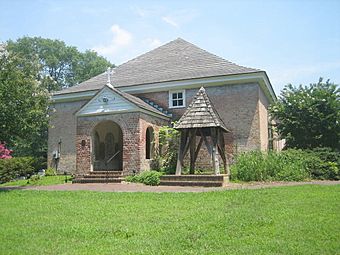St. John's Episcopal Church (Fort Washington, Maryland) facts for kids
Quick facts for kids |
|
|
St. John's Church
|
|

St John's Church, Fort Washington, MD
|
|
| Location | 9801 Livingston Rd., Fort Washington, Maryland |
|---|---|
| Area | 3 acres (1.2 ha) |
| Built | 1767 |
| Architectural style | Gothic Revival |
| NRHP reference No. | 74002202 |
| Added to NRHP | April 8, 1974 |
St. John's Church, also called St. John's Episcopal Church, is a very old and important church in Fort Washington, Maryland. It's a special building made of brick with a unique roof. Inside, the ceiling looks like a big, curved tunnel. This church has been a place of worship for a long, long time!
Contents
A Long History: St. John's Church
This church site is the oldest one in Prince George's County, Maryland. It was one of the first 30 churches set up in the Maryland colony. In 1692, the government created "King George's Parish." This parish was named after the local Piscataway tribe.
People in the area chose leaders for the church in 1693. They bought land and started building the first church. This first church, made of wood, was finished in 1695. It was called the "Broad Creek Church."
Over the years, new churches were built on the same spot. The current brick building is the fourth one. It was finished between 1767 and 1768. People still gather here for services every week.
Other Churches and Important People
As the area grew, more churches were built nearby. These were called "Chapels of Ease." They helped people who lived too far from the main church. One was built in 1696 at Seat Pleasant, Maryland. Another was built in 1698 at Accokeek, Maryland.
St. John's Church is like a "mother church" for many other Episcopal churches. These churches are in Prince George's County, Montgomery County, Maryland, and even Washington, D.C.. For example, St. Paul's Parish in Rock Creek started from St. John's.
Many important people were part of St. John's history. Reverend Henry T. Addison was the church's leader from 1743 until 1776. Later, Thomas John Claggett became the church's leader. In 1793, he became the first bishop (a high-ranking church leader) in the new Episcopal Church in America.
Bishop Claggett also led the first confirmation ceremony for young people in the new church. Forty-four young people were confirmed. Another important person was Reverend Walter Addison. He became the first priest to be ordained (officially made a priest) in America by Bishop Claggett.
George Washington's Visits
Did you know that George Washington, the first President of the United States, sometimes attended services here? He would visit the Broad Creek church or the Accokeek chapel. This happened when bad weather made it hard to travel to his home church in Alexandria, Virginia. He was a leader at his own church, Christ Church (Alexandria, Virginia).
Inside and Out: The Church Building
St. John's Church has some interesting features. Outside, there's a tall structure called a "campanile." It has four tall posts with a roof, and a bell hangs underneath.
Inside, there's a unique opening in the gallery (a balcony area). This small opening was used to collect offerings from people sitting in the gallery. The front porch of the church was added later, in the 1800s.
One of the church pews (long benches) has a silver plate. It says: "In memory of George Washington - - Restored by his Great-Great-Great Grandnephew, George W. Magruder, 1895." This shows how important George Washington was to the church's history.
St. John's Church is part of the Episcopal Diocese of Washington. This group helps lead Episcopal churches in the Washington, D.C. area. The church is also connected to the larger Episcopal Church in the U.S.A. and the worldwide Anglican Communion.
Gallery













